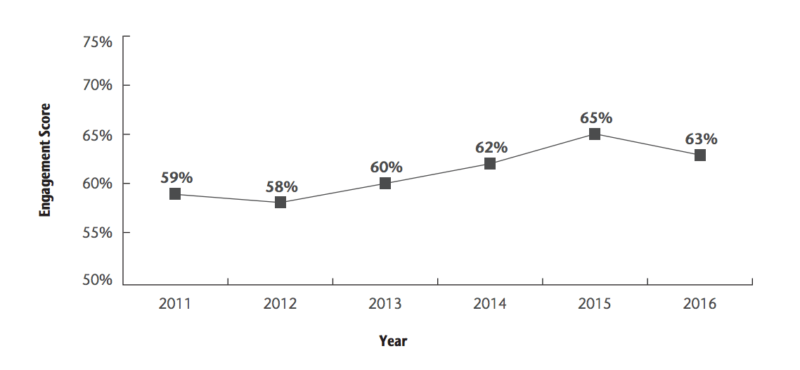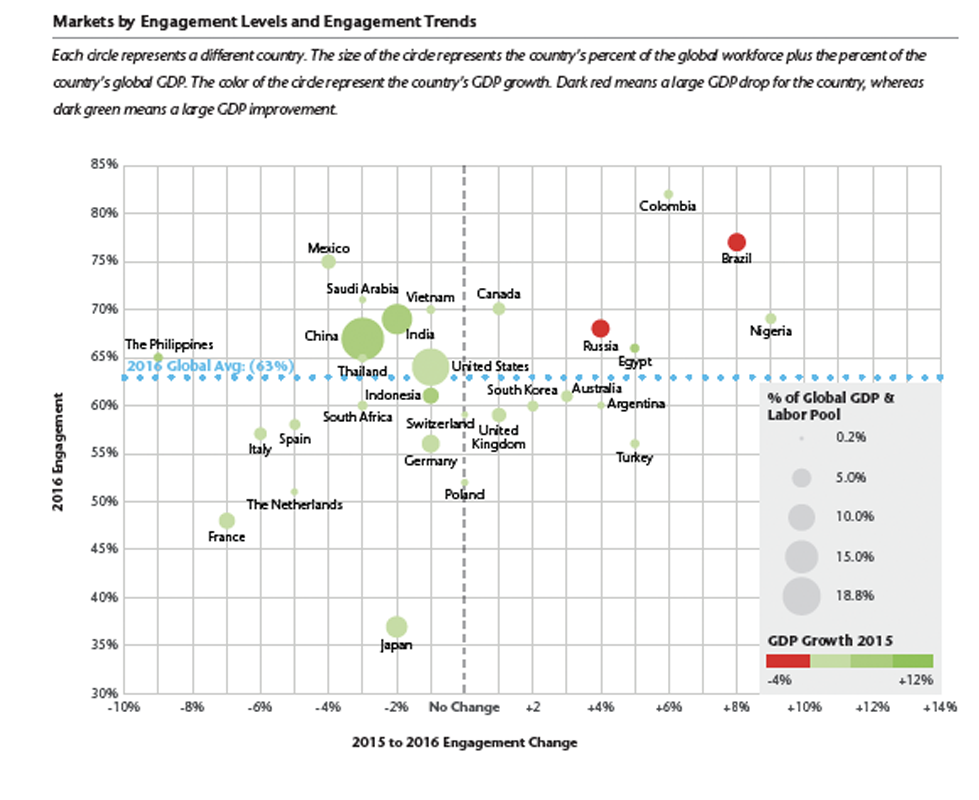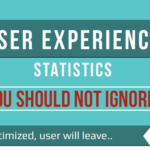Employee engagement statistics. This is a growing compilation of statistics on the state of employees and how engaged or not they are whilst at work. Engagement rates have a direct correlation to productivity and performance [cm_simple_footnote id=”1″].
Employee Engagement Statistics
These employee engagement statistics tell a story. There are challenges for leadership and managers in competing and managing talent.
Employee Engagement Statistics – An Overview
- In 2016 33%?of American workers are engaged (Gallup).
- In 2016 51%?of the U.S. workforce are?not engaged (Gallup).
- 63%?of the workforce is?engaged?in 2016?(24%?highly engaged,?39%?were moderately engaged) (Aon Hewitt).
- 16%?of employees are “actively disengaged”?in 2016?(Gallup).
- US companies dropped employee engagement levels from?65%?in 2015 to?63%?in 2016 (Aon Hewitt).
- Companies that increase their number of talented managers and double the rate of engaged employees achieve, on average,?147% higher earnings per share?than their competition (Gallup).
- In 2017, more than half of job seekers are satisfied at work (64%) ? but?82%?of them are open to new job opportunities. (Jobvite).
- 37%?of employees indicated they were ?very satisfied? and?51%??somewhat satisfied? with their jobs?(SHRM, 2017).
- 86%?of employees say they’re at least somewhat happy with their jobs,?43%?are very happy, just 4% very unhappy (Staples).
- 67%?of employees are extremely or very satisfied with their jobs (Aflac).
- The industries with the highest employee engagement are heavy manufacturing and financial services (Modern Survey).
- The industries with most disengaged workers at hospitality, government and light manufacturing?(Modern Survey).
- 71% of full-time state and local government workers are unhappy or disengaged with their jobs (Gallup).
- The number of highly and moderately engaged employees in the U.S. increased from 55% last year to 57% this year (Temkin Group).
- 30% of employees who work from home are engaged (Gallup).
- 36% of businesses see engagement as a top challenge (Globoforce).
- Only 55% of organizations have an explicit employee engagement strategy (Edelman).
- Among those that do have a strategy, 86% of senior leaders are familiar with it, along with only 65% of managers and 38% of employees (Edelman).
- 26% of HR?professionals say employees at their organizations have a strong understanding of the concept of employee engagement (Modern Survey).
- Declining employee loyalty is thought to harm organizations by causing low morale (84%), high turnover (80%), disengagement (80%), growing distrust (76%), and lack of team spirit (73%) ?(American Management Association).
Employee Engagement Statistics ? Location
- State with the highest employee engagement: Alabama (37% of workforce); West Virginia is the lowest (21% of workforce actively disengaged) (Gallup).
- Cities with highest percentage of engaged workers: San Antonio (38.1%), Oklahoma City (37.6%), Riverside, Cali. (36.8%) and Tulsa (36.3%) (Gallup).
- Cities with lowest percentage of engaged employees: Buffalo (23.5%), San Jose (24.7%), Minneapolis (24.9%), DC (25.9%) (Gallup).
Employee Engagement Statistics – Employee Turnover
Ultimately companies feel the negative effect of a poor employee engagement?in the form of?employee turnover.
- In 2016 51%?of workers are looking to leave their current jobs (Gallup).
- 40%?of employees are considering employment outside of their current firm within the next year (SHRM).
- 34%?of employees say they plan to leave their current role in the next 12 months (Mercer).
- Total turnover?in 2016😕17.8%?of the workforce (Compensation Force).
- Total voluntary turnover?in 2016😕12.8%?of the workforce (Compensation Force).
- Industries with highest turnover in?2016: Hospitality (28.6%),Healthcare (19.9%), Banking & Finance (18.1%), (Compensation Force).
- 73%?of employees are open to hearing about new opportunities (TopResume).
- 13%?of employees say they love their job and are not looking for other opportunities (TopResume).
- 11%?of employees say they don?t love their job, but they?re not sure if it?s time to leave it (TopResume).
- 59%?of employees would leave their profession if they could (CareerCast).
- 3%?of employees say they?re unsure of their feelings toward their current job (TopResume).
- 69%?of hiring managers say voluntary turnover has not increased at their companies in 2016 (DHI Group).
- 37%?of employers say turnover has picked up over the past 12 months; 16% say it?s dropped off (Willis Towers Watson).
- The average employee tenure is eight years, the annual turnover rate is 19% and the involuntary turnover rate is 8% (SHRM)
- 45%?of?employees reported that they would be likely or very?likely to look for other jobs outside their current?organization within the next year (SHRM).
- 45% of employees plan to stay at their jobs for at least another year (MetLife).
- 50% of employees say that are planning to stay at their current company for two years or less (Execu-Search).
- 59% of US workers are likely to leave their jobs for new opportunities (Adobe).
- 50% of employees who say they love their current jobs would still leave for a new opportunity if given the chance (Adobe).
- For every additional 10 months an employee stagnates in a job role, they are 1% more likely to leave the company (Glassdoor).
- 47% of Americans would leave for their ideal job even if it meant less pay (Adobe).
- 50% of referred employees stayed in their positions five years on average (SilkRoad).
- 47% of workers report that they have had to replace more than 20% of their workforce during the past 12 months (Spherion).
- The attrition rate of disengaged employees is 12x higher than highly engaged employees over the period of a year (Glint).
- The average American worker spends 15 months in one role (Glassdoor).
- 40% of companies are reporting loss of personnel as a top concern (SHRM).
- 35% of employees have changed jobs within the past three years; 91% of these left their company to do so (Gallup).
- 67% of decision-makers say they?re more concerned about turnover at their organizations now than they were 12 months ago (Randstad).
- 27% of employees change jobs each year, 17% are actively job-hunting and 46% are passively looking (ADP).
- 1 in 3 workers will change jobs in the next 6 months (Saba Software).
- 28% of employees have considered leaving their employer and moving to a competitor within the last 12 months (Mercer).
- 69% of employees are open to other opportunities or already seeking their next job (Rapt Media).
- 33% of leaders at organizations with 100+ employees are currently looking for a job at another organization (Modern Survey).
- 93% of US adults say they left their employer in order to change roles (Gallup).
Employee Engagement Statistics ? Financial Impact Of Employee Turnover
These employee engagement statistics focus on the?financial impact of high employee turnover.
- Cost of replacing entry level employees:?30-50%?of their annual salary?(ERE Media).
- Cost of replacing mid-level employees:?150%?of their annual salary?(ERE Media).
- Cost of replacing high-level or highly specialised employees:?400%?of their annual salary (ERE Media).
- $11 billion?is lost annually due to employee turnover (Employee churn calculator,?UK figures,?).
- Disengaged employees cost organizations between $450 and $550 billion annually (The Engagement Institute).
- 33% of senior leaders believe employee loyalty has a direct relationship to profits (American Management Association).
- Actively disengaged workers are nearly twice as likely as engaged workers to have been diagnosed with depression (Gallup).
- Depression and anxiety lead to 15 billion lost days of work every year, at an estimated annual cost of US $1.15 trillion.
- 38% of employers say lack of qualified talent is the greatest reason for productivity lost within their organization (Aflac).
- On a monthly basis, actively disengaged employees have 2.17 unhealthy days, compared with 1.25 unhealthy days for engaged employees (Gallup).
- An engaged worker aged 40-49 costs $127.76 per month in lost productivity due to unhealthy days, while an actively disengaged worker in the same age range costs $236.20?an 85% increase?(Gallup).
- 8% of global employees are actively disengaged and intend to stay at their organization (Aon Hewitt).
- 21% of employees who have been with one company for 10+ years are disengaged, more than any other tenure period (Gallup).
- 26% of U.S. employees say they will look for a new job within the next 12 months, 15% are already actively looking for a new job (Dale Carnegie Training).
- 83% of full-time employees would consider leaving their current company (ICIMS).
- Replacing a lost employee costs 150% of that person?s annual salary (Columbia University) (2009 statistic).
- Replacing an experienced worker can cost 50% or more of the individual’s annual salary in turnover-related costs (AARP).
- Businesses spend about one-fifth of an employee?s annual salary to replace that worker (Center for American Progress).
- Total cost of replacing an employee estimated to be between 90% to 200% of his/her annual salary (SHRM).
- Disengaged managers cost the U.S. $77 billion to $96 billion annually (Gallup).
- 77% of employees in companies that have significantly better financial performance than their peers are highly or moderately engaged, compared with only 49% of employees in companies with lagging financial performance (Temkin Group).
Employee Engagement Statistics – The Benefits of Engaged Employees
- Companies highest performing employees have three things in common: talent, engagement, and 10+ years of service (Gallup).
- Companies that outpace their competitors in CX have 50% more engaged employees than those with CX that lags their peers (Temkin Group).
- Higher workplace engagement leads to 37%?lower absenteeism, 41%?fewer safety incidents,?and 41% fewer quality defects (Gallup).
- Workers in the top 1% in terms of productivity add about $5,000 to profit per year, while a toxic worker costs about $12,000 per year (Harvard).
- 91% of highly engaged employees always or almost always try their hardest at work, compared with 67% of disengaged employees (Temkin Group).
- Customer retention rates are 18% higher on average when employees are highly engaged (Cvent).
- Companies with engaged employees see 233% greater customer loyalty and a 26% greater annual increase in revenue (Aberdeen).
- Employee engagement programs can increase profits by $2400 per employee per year (Workplace Research Foundation).
- Organizations that have over 50% employee engagement retain over 80% of their customers (Demand Metric).
- Employees who say their organizational values are ?known and understood? are 51 times more likely to be fully engaged than an employee who responds that their organization does not have values that are known and understood (Modern Survey).
- 77% of ?employees who strongly agree that they know what their company stands for and what makes it different from competitors strongly agree that they plan to be with the company for at least one year (Gallup).
- Organizations in which employees are primarily motivated by shared values and a commitment to a mission and purpose are nine times more likely to have high customer satisfaction (LRN).
- Employees who work for “dream companies” are 11x more likely to stay at their company than those in dream jobs, have 41% more satisfaction, and are 3.5x more likely to say that their job inspires them (Bright Horizons).
- When companies select the top 20% most talented candidates for a role, they frequently realize a 10% increase in productivity, 20% increase in sales, 30% increase in profitability, 10% decrease in turnover and a 25% decrease in unscheduled absences (Gallup).
Highly engaged employees are:
- 2.5 times more likely to stay at work late if something needs to be done after the normal workday ends.
- more than twice as likely to help someone at work even if they don?t ask for help.
- more than three times as likely to do something good for the company that is not expected of them.
- more than five times as likely to recommend that a friend or relative apply for a job at their company (Temkin Group).
Employees who are engaged?and?have high well-being are:
- 42% more likely to evaluate their overall lives highly.
- 27% more likely to report “excellent” performance in their own job at work.
- 27% more likely to report “excellent” performance by their organization.
- 45% more likely to report high levels of adaptability in the presence of change.
- 37% more likely to report always recovering “fully” after illness, injury or hardship.
- 59% less likely to look for a job with a different organization in the next 12 months.
- 18% less likely to change employers in a 12-month period.
- 19% more likely to volunteer their time in the past month (Gallup).
Employee Engagement Statistics ??Employer Perspective
- The top three challenges faced by HR organizations today are turnover, employee engagement, and succession planning (SHRM).
- 56% of executives say promoting loyalty is “not a major focus, but valued nevertheless” (American Management Association).
- 24% of executives say promoting employee loyalty was “never valued nor a major focus” (American Management Association).
- 32% of employers said they have come to expect workers to job-hop (CareerBuilder).
- 52% of companies report their employees are less loyal than five years ago (American Management Association).
Employee Engagement Statistics ? ?Talent Management
- 78% of businesses are more worried about a talent shortage than they were last year?(Spherion).
- 62% can’t afford to meet new salary increase demands even though they think it’s right to do so?(Spherion).
- 78% of HR leaders are more concerned about the talent shortage today than they were a year ago (Spherion).
- 68% of the human resource professionals say last year they experienced recruiting difficulty and skill shortages for certain types of jobs (SHRM).
- 83% of employers believe attracting and retaining talent is a growing challenge (Allegis Group).
- 53% of HR pros say that the highest priority in the coming year is to retain top talent (Xerox).
- 87% of human resource leaders say improved retention is a high / critical priority (Kronos).
- 24% of CHROs say engaging and retaining employees is their biggest struggle (Korn Ferry).
- 34% of companies focus on developing and retaining current employees (American Management Association).
- 90% of executives said keeping new hires is an issue in their organizations (Korn Ferry).
- 46% of HR pros say retention is their greatest concern, followed by employee engagement at 36% (SHRM).
- 46% of HR pros list retention as their top challenge (Globoforce).
- 24% of US businesses employing hourly workers say employee retention is their top problem (Deputy).
- 75% of companies agree it takes more time this year than last year to find the right talent to fill positions (Randstad).
- 80% of HR pros say?that employee engagement is an important area of focus for their organization (Temkin Group).
- 49% of HR leaders named retention and leadership development programs as the top priority among talent management goals (Saba Software).
- 16% of HR leaders?say a lack of budget is the primary obstacle to improving employee retention in the next 12 months (Kronos).
- 14% of HR leaders say lack of executive support is an additional obstacle to improving retention in 2017; 13% cite a lack of organizational vision?(Kronos).
- 15% of HR leaders?say a lack of funding is the biggest challenge to improving employee engagement (Kronos).
- 56% of employers reported difficulty retaining high-potential employees and top performers (54%) (Towers Watson).
- 32% of companies struggle to retain top talent (CareerBuilder).
- 50% of organizations report difficulty recruiting for?full-time, regular positions over the past 12 months (SHRM).
- 62% of employers said that they would extend a counter offer in order to keep their best employees (Execu-Search).
- 80% of HR leaders think their organizations will be affected by scarcity of talent this year (Randstad).
- 51% of employers say that using benefits to retain employees will become even more important in the next 3 to 5 years (MetLife).
Employee Engagement Statistics ? ?Boomerang Employees
- 98% of HR pros are open to hiring former employees (Accountemps).
- 76% of employers are now more accepting of hiring ?boomerang? employees ? or employees who have previously worked for the employer (Workplace Trends).
- 29% American workers say they have ?boomeranged? at least once in their career, and 41% say they would consider going back to a former workplace (Spherion).
- 52%) of employees?said their company currently employs at least one boomerang worker?(Spherion).
- 37% of employees believe their company favors hiring boomerang employees to save money on recruitment and training, while also minimizing risk?(Spherion).
Employee Engagement Statistics -?The Leadership Effect
- Only 41% of employees strongly agree that they know what their company stands for and “what makes it different from competitors.” (Gallup).
- A 10% improvement in employees’ connection with the mission or purpose of their organization would result in a 12.7% reduction in safety incidents, an 8.1% decrease in turnover, and a 4.4% increase in profitability (Gallup).
- 47% of US workers don?t know or are unsure of what their employers? core values are (Eagle Hill Consulting).
- 80% of employees felt more engaged when their work was consistent with the core values and mission of their organisation (IBM).
- 85% of employees said they were likely to stay longer with an employer that showed a high level of social responsibility (Ultimate Software).
- 51% of employees who don?t feel they have the support of leadership plan to leave their job in the next year, compared to 25% of those who do have leadership support (American Psychological Association).
- In companies where both leaders and managers are perceived by employees as effective, 72% of employees are highly engaged (Towers Watson).
- 80% of those dissatisfied with their managers are also disengaged from their employers (Dale Carnegie).
- 70% of employees who lack confidence in senior leadership are not engaged with their employer (Dale Carnegie).
- 86% of C-suite leaders and 76% of senior management say corporate America is headed in the right direction, compared to 54% of staff-level employees (Addison Group).
- 83% of executives say they will be increasing the use of contingent, intermittent or consultant employees (Oxford Economics).
- Only 22% of senior decision-makers don?t think that regular recognition and thanking employees at work has a big influence on staff retention; 70% of employees say that motivation and morale would improve ?massively? with managers saying thank you more (Reward Gateway).
- 86% of values-based recognition programs show an increase in worker happiness (SHRM).
- 57% of employees feel their leaders are detached from the workforce ?(Rapt Media).
- 44% of employees say that leadership at their companies is equipped to lead their organizations to success (Oxford Economics).
- Only 1 in 150 employees who say their organization does not have a set of values are fully engaged (Modern Survey).
Employee Engagement Statistics – ?The Management Effect
- Employees who are supervised by highly engaged managers are 59% more likely to be engaged (Gallup).
- Just 35% of U.S. managers are engaged, while 51% are not engaged (Gallup).
- 54% of employees who feel they can approach their manager with any type of question are highly engaged (Gallup).
- 50% of US adults have left their job to get away from their manager (Gallup).
- Managers account for at least 70% of variance in employee engagement scores (Gallup).
- 65% of employees who?don’t?feel they can approach their manager with any type of question are actively disengaged (Gallup).
- Among employees who strongly agree that their manager helps them set performance goals, 69% are engaged (Gallup).
- Engagement plummets to 2% among teams with managers who ignore their employees, compared 61% for teams led by managers who focus on strengths (Gallup).
- 68% of employees say their managers aren’t actively engaged in their career development (Right Management).
- Teams led by managers who focus on their weaknesses are 26% less likely to be engaged (Gallup).
- Employees who believe that only obedience, predictability, deference to authority and competition with peers are valued are 32% less likely to be engaged, motivated and committed (Vitalsmarts).
- 21% of employees strongly agree that their performance is managed in a way that motivates them to do outstanding work (Gallup).
- 67% of employees who strongly agree that their manager focuses on their strengths or positive characteristics are engaged (Gallup).
- Employees who believe their managers can name their strengths are 71% more likely to feel engaged and energized?(The VIA Institute on Character).
- 33% would change to more empathetic employers?for equal pay, and 20%?would switch companies for?less?pay (Businessolver).
- 92% of employees say showing empathy is an important way to advance employee retention (Businessolver).
- 66% of employees agree employers should express empathy through benefit packages, rather than corporate social responsibility (CSR) programs (Businessolver).
- People who use their strengths every day are six times more likely to be engaged at work, 8% more productive and 15% less likely to quit their jobs (Gallup).
- 98% of HR professionals and 92% of employees surveyed said empathetic employers drive retention (Businessolver).
- 70% of employees ranked being empowered to take action at work when a problem or opportunity arose as an important element of their engagement?(SHRM).
- 32% of all employees want to see and understand the progress they’ve made toward goals set by their manager (Ultimate Software).
Employee Engagement Statistics – The Team Effect
- Highly engaged business units result in 21% greater profitability (Gallup).
- Highly engaged business units realize a 41% reduction in absenteeism and a 17% increase in productivity (Gallup).
- Highly engaged business units achieve a 10% increase in customer ratings and a 20% increase in sales (Gallup).
- Teams that address engagement needs in their everyday work outperform bottom teams by an average 20% in sales and 10% in customer engagement (Gallup).
- Business units with high employee engagement have 28% less internal theft and 21% higher productivity (Gallup).
- 33% of employees say the ability to collaborate makes them more loyal?(The Economist).
- 46% of professionals worldwide believe that work friends are important to their overall happiness (LinkedIn).
Employee Engagement Statistics ? Employee Perspective
- Belief in senior leadership is the strongest engagement driver, growth & development is the second (Modern Survey).
- Only 10% of employees define career success as high performance and productivity (Right Management).
- 45% of employees say their?top definition of workplace success is enjoyment/happiness (Right Management).
- 18%?of employees don?t feel confident that an employer will take care of them (Job Applicator Center).
- 52%?of employees feel confident their employer will repay them for their loyalty ?(Job Applicator Center).
- 56%?of employees want more flexible work options?Mercer.
- 24% of workers say their employers are putting in less effort to retain them; 15% say they are putting in more effort (Spherion).
- 60% of HR leaders believe that their companies provide employees with a clear career path; just 36% of employees agree (Saba Software).
- 75% of employees would stay longer at an organization that listens to and addresses their concerns (Ultimate Software).
Employee Engagement Statistics ??Employee Commitment
- 87% of employees say they?re ?highly committed? to their organization ?(ReportLinker).
- 47% of employees report feeling very loyal to their company (Metlife).
- 66% of older employees say they are ?highly? committed ?(ReportLinker).
- Employees earn a 5.2% pay increase on average when changing jobs (Glassdoor).
- A 10% increase in base pay increases the odds an employee will stay at the company by 1.5 percent (Glassdoor).
Employee Engagement Statistics ? Viewing the?Job Market
- 39% of job seekers say it’s harder to find a job now than the year before (Jobvite).
- 51% of students say it is a good time to find a quality job (Gallup).
- 49% of workers agree that their ability to find a new job has increased significantly over last year (Spherion).
- 51% of Americans say now is a good time to find a good job in their local area (Gallup).
- 51% of employees feel the expanding job market gives them more power to negotiate a higher salary, either with their current company or with another (Spherion).
- 44% of job seekers are optimistic that they’ll be able to find a job that suits their skills and qualifications?(Jobvite).
- 63% of US workers say they likely would find a new job just as good as their current one if laid off (Gallup).
- 48% of employees are confident they can find a job that matches their compensation level within six months of starting to hunt (Glassdoor).
Employee Engagement Statistics ??Career?Opportunities
- 40% of employees choose to leave a job because of a “lack of advancement/opportunity” (Express Employment Professionals).
- 78% said they would remain longer with their employer if they saw a career path with the current organization (Mercer).
- 32% of employees say they have a job, not a career (Mercer).
- 41% of employees said they would need to leave their current employer in order to advance their careers (Towers Watson).
- 42% of employees?say they expect to have three or more careers in their lifetimes?(Cornerstone).
- 89% of employees would consider a lateral move within their company, but?only 27% of them would consider a lateral move to work for a different company?(Cornerstone).
- 66%?of employees will first look to see if there is an interesting and open position at their current company before looking elsewhere?(Cornerstone).
- 22% of employees who are not getting promoted look to other companies for opportunities to advance their careers (BambooHR).
- 60% of employers believe employees often hear about new job openings within the company, only about 30% of employees say they actually do (ADP).
- 83% of employees with opportunities to take on new challenges say they?re more likely to stay with the organization (ReportLinker).
- 54% said career advancement opportunities are more important than salary when looking for work (Achievers).
- 59% of employees say they can “grow and develop” at their organization (Modern Survey).
- 33% of employers who have raised educational requirements have seen a positive effect on employee retention (CareerBuilder).
- 27% of workers strongly agree that the feedback they currently receive helps them do their work better (Gallup).
- 32% of workers believe their current skills will prevent them from earning a promotion (Spherion).
Employee Engagement Statistics ??Onboarding
- 53% of HR professionals say employee engagement rises when onboarding is improved (SilkRoad).
- 28% of new hires are willing to quit their new jobs if they don?t find it satisfactory in the first 90 days (Robert Half).
- New hires who reported a poor onboarding experience are 8x more likely to be disengaged in their work and 11x less likely to recommend their employer as a good place to work after their first three months (Glint).
- 98% of executives say onboarding programs are a key factor in retention efforts (Korn Ferry).
Employee Engagement Statistics ? Stress At Work
- 60% of workers say work-related pressure has increased in the last five years (Accountemps).
- Top sources of workplace stress: Heavy workload/looming deadlines (33%), Unrealistic expectations of managers (22%), Attaining work-life balance (22%), Coworker conflicts (15%) (Accountemps).
- Top workplace stressors: deadlines (30%), physical risk (17%), competitiveness (10%) (CareerCast).
- 80% of employees? say their greatest source of stress is not spending as much time at home (Paychex).
- 82% of employees said their jobs fall on the more stressful end (CareerCast).
- 92% of employers say their workforce is stressed (IFEBP).
- 47% of employees report that stress causes them performance issues at work (ARAG).
- 35% of workers feel burned out (Kimble Applications).
- 33% of employees say they must work long hours to get work done and stay ahead of their workload (Kimble Applications).
- 68% of U.S. full-time employees are suffering from work overload (Cornerstone).
Employee Engagement Statistics ??Work / Life Balance
- 35% of employees say their top motivations for changing jobs are the desire for work/life balance and higher compensation; 25% say it’s?different work culture and wanting more challenging assignments (Right Management).
- 22% of people have changed jobs due to work/life balance issues?(Staples).
- 38% of employees cite work responsibilities and 30% cite work/life balance as leading contributors to their loyalty?(Staples).
- 82% of employees say they would be more loyal to their employers if they had flexible work options?(Flexjobs).
- 79% of employees with flexibility indicated that they were more happy at work (IBM).
- Career satisfaction and work-life balance are the top reasons American employees stay at their current jobs (38% combined) (Cornerstone).
- 29% of American employees resign due to work overload and lack of healthy work-life balance (Cornerstone).
- 60% say their companies don’t appear to care about their child care needs (Care.com).
Employee Engagement Statistics ? Pay and Benefits
- Top employer attributes that jobseekers value most: salary and employee benefits, long-term job security, pleasant working atmosphere (Randstad).
- 35% of employees report they will look for a new job if they do not receive a pay raise in the next 12 months (Glassdoor).
- 44% of employees say they would consider taking a job with a different company for a raise of 20% or less (Gallup).
- 10% of employees think they?re not being paid what they?re worth so much that they?ll quit their job (BambooHR).
- Just 37% of engaged employees would consider leaving for a 20% raise or less, compared to 54% of actively disengaged employees?(Gallup).
- 46% of employees would consider a job that matched their current salary or even paid less (ADP).
- 65% of employees left jobs in 2015 because they wanted more money (Payscale).
- 86% of employees said they?d stay with a company for at least five years if their employer helped pay down their student loans (American Student Assistance).
- 45% of employees would feel more engaged with their job if their employer helped them better understand the impact of taxes and deductions (Kronos).
- 72% of employees say that having the ability to customize their benefits would increase their loyalty to their current employer (MetLife).
- 59% of employees say that health and wellness benefits are important for increasing loyalty to their employer and 53% say the same about financial planning programs (MetLife).
Employee Engagement Statistics ??Corporate Social Responsibility
- 54% of employees who are proud of their employer’s contributions to society are engaged (Dale Carnegie).
- 61% of employees say it is important for them to work at an organization that is socially responsible? (Modern Survey).
- 35% of workers say an eco-friendly workplace is important to consider when looking at a new job, compared to over 50% of Millennials (Staples).
- 90% of millennials said they consider a company’s sustainability important, compared to 84% of GenX and 77% of Boomers (Lightspeed).
- 63%?of workers prioritize sustainability?when considering employment (Staples).
- 86% of new professionals/soon to be college graduates say it?s important that the company they work for behaves in a socially responsible way (Nielsen).
- 50% of those under the age of 40 felt that a company?s approach to sustainable business practices have influenced their decision about accepting a job (Bain & Co).
Employee Engagement Statistics ??Technology
- Employers?rated by employees as ?pioneers? in supporting mobile technology saw better?productivity (16%), creativity (18%), satisfaction (23%)?and loyalty (21%) (The Economist).
- 85% of employees who feel their company?s technology is ahead of the curve say they love their jobs (Adobe).
- 70% of employees believe technology improves work-life balance (Adobe).
- 92% of employees say that having the technology to do their job efficiently affects their work satisfaction (Ultimate Software).
- 36% of employees say they would leave for a job with a more “digitally progressive” employer ?(Sungard).
Employee Engagement Statistics ? ?Gender
- 35% of female employees are engaged compared to 29% of men (Gallup).
- 41% of women managers are engaged compared to 35% of male managers (Gallup).
- 63% of young females agree that employees should stay in their first job between 2-3 years, compared to 54% of males (Adecco).
- 58% of women without young children would rather work outside the home (Gallup).
- 32% of young women only keep their existing jobs just to pay off college debt (1000 Dreams Fund).
- 52% of women and 50% of men view greater job stability and security as “very important” in a new job (Gallup).
- 25% of women talk with their managers about developing leadership skills (Right Management).
- Among women who feel supported by male leadership, 54% reported better raises, promotions and assignments (Working Mother).
- 21% of young women have been the victim of sexism in the workplace (1000 Dreams Fund).
- 71% of women and 74% of men at companies that don?t address gender inequality said they would look for jobs elsewhere in the next six months (PayScale).
- 20% of women vs. 44% of men say they are completely satisfied with the amount they earn (Gallup).
- 12% of women say they have been passed over for a promotion or other opportunity because of their gender?(Gallup).
- 5% of men?say they have been passed over for a promotion or other opportunity because of their gender (Gallup).
- 17% of working women say they have been denied a raise because of their gender (Gallup).
- 4% of working men?say they have been denied a raise because of their gender (Gallup).
- 59% of men and 56% of women say advancing in their career is extremely or very important to them (Gallup).
- 75% of women do not believe men and women are paid equally, compared to 50% of men (Glassdoor).
- When asked to rank what signified a career advancement to them, women ranked ?more money? and ?a higher title? higher than men, who?ranked ?more direct reports,? ?expanded responsibility? and ?more face time with company executives? higher than women (BambooHR).
- 54% of female employees say they are recognized when they do excellent work. For males, it is 61% (Modern Survey).
Employee Engagement Statistics ??Small Business
- 75% of small business employees are very or extremely happy working for a small employer (Aflac).
- 89% of employees age 71 and older say they are very or extremely happy working for a small employer, compared with 70% of workers ages 18 to 36 (Aflac).
- Top five reasons employees say they like working for small businesses: flexible scheduling (27%), seeing the fruits of their labor (23%), feeling their input matters (17%), being rewarded for hard work (14%) and getting noticed by people who matter (9%) (Aflac).
- 86% of small business employees say they know how their job fits into their employer?s long-term plans (Aflac).
- 26% of small-business employees would jump ship to a larger company if it meant better benefits offerings (Aflac).
Employee Engagement Statistics ?Age
- 41% of employed workers over the age of 50 have spent two decades with the same company, including 18% who’ve stayed at least 30 years (Associated Press).
- 45% of HR professionals say it is easy/extremely easy to retain older workers (SHRM).
- Among HR professionals who claim difficulty in retaining older workers, 47% cite work location inflexibility as the biggest challenge, 45% cite career inflexibility, 44% cite work hours inflexibility (SHRM).
- 4% of organizations have a strategy for retaining older workers (SHRM).
- 40% of employees planning to work past 70 feel they are stuck in their jobs, compared with just a quarter of those who expect to retire at 65 (28%) or before 65 (27%) (Willis Towers Watson).
- 75% of Americans expect to work as long as possible (Bankrate).
- 81% of executives believe that Boomers will retire at least five years later than they had planned prior to the recession?(Korn Ferry).
























